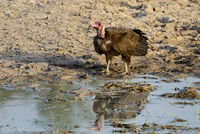Difference between revisions of "Hooded vulture"
m |
m |
||
| Line 19: | Line 19: | ||
|infraclass= | |infraclass= | ||
|superorder= | |superorder= | ||
| − | |order= | + | |order=Accipitriformes |
| − | |suborder= | + | |suborder=Accipitres |
|infraorder= | |infraorder= | ||
| − | |superfamily= | + | |superfamily=Accipitroidea |
| − | |family=Accipitridae | + | |families= |
| + | |family=Accipitridae | ||
|subfamily=Aegypiinae | |subfamily=Aegypiinae | ||
|supertribe= | |supertribe= | ||
Latest revision as of 18:21, June 22, 2019
| Hooded Vulture | |
|---|---|

| |
| Scientific classification | |
| Kingdom Information | |
| Domain | Eukaryota |
| Kingdom | Animalia |
| Subkingdom | Bilateria |
| Phylum Information | |
| Phylum | Chordata |
| Sub-phylum | Vertebrata |
| Infraphylum | Gnathostomata |
| Class Information | |
| Superclass | Tetrapoda |
| Class | Aves |
| Sub-class | Neornithes |
| Order Information | |
| Order | Accipitriformes |
| Sub-order | Accipitres |
| Family Information | |
| Superfamily | Accipitroidea |
| Family | Accipitridae |
| Sub-family | Aegypiinae |
| Genus Information | |
| Genus | Necrosyrtes |
| Species Information | |
| Species | N. monachus |
| Population statistics | |
| Population | 197,000 (2016) |
| Conservation status | Critically endangered[1] |
The hooded vulture (Necrosyrtes monachus) is a bird of prey from the subfamily of the Old World vultures, Aegypiinae.
Description
The hooded vulture is a comparatively small, about 24–28 inches in length, a wingspan of 65 inches, and a body weight of 3.3–5.7 pounds. The plumage is dark brown throughout, with blackish-brown primary and secondary flight feathers. The head forward of the ears and the front half of the neck are naked, and rosy in color; behind is a well-defined placement of short light-brown feathers, giving the bird an appearance of wearing a "hood", hence the name.
The bird is common in Africa south and west of the Sahara, with the exception of the tropical rainforest and the extreme south of the continent. It breeds all year. Like some other representatives of its subfamily it is a scavenger, in the vicinity of the settlement it also consumes garbage, including waste from slaughter houses and human excrement. It penetrates as far as the coast where it captures marine arthropods, mollusks, and fish.
Threats
The hooded vulture was listed as "least concern" by the IUCN as late as 2009; two years later it was upgraded to "endangered", then to "critically endangered" in 2015. The reasons given are the following:
- Illegal targeting and killing of the birds by poachers, as they are seen as "giving away" the locations of large animal kill sites, such as rhinos and elephants.
- Secondary poisoning by carbofuran pesticides at carcass bait traps, which are used to control predatory mammals from killing domestic livestock.
- Human consumption, for supplementary diet and folk medicinal properties.
Current research data indicates the species will suffer a population decline of some 83% over the next three generations.